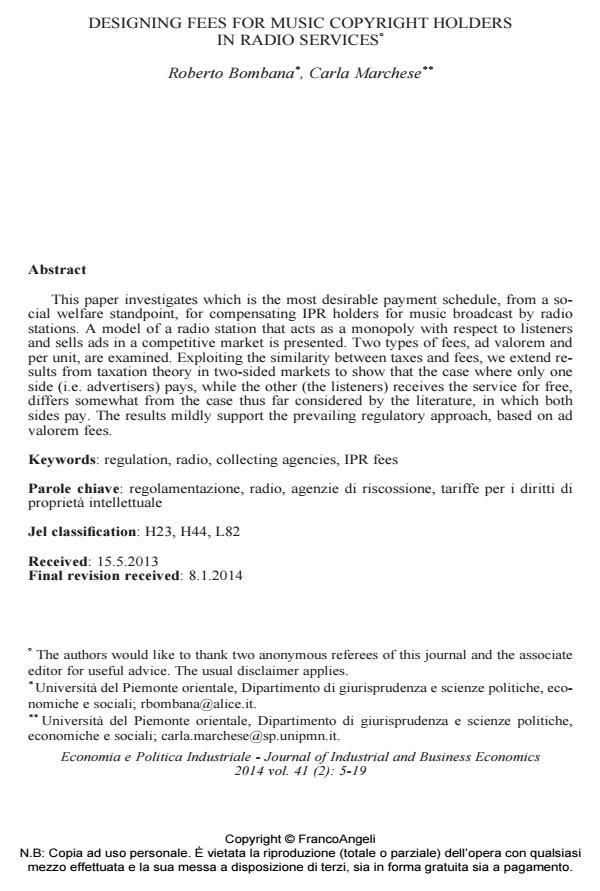Designing fees for music copyright holders in radio services
Titolo Rivista ECONOMIA E POLITICA INDUSTRIALE
Autori/Curatori Roberto Bombana, Carla Marchese
Anno di pubblicazione 2014 Fascicolo 2014/2
Lingua Inglese Numero pagine 15 P. 5-19 Dimensione file 117 KB
DOI 10.3280/POLI2014-002001
Il DOI è il codice a barre della proprietà intellettuale: per saperne di più
clicca qui
Qui sotto puoi vedere in anteprima la prima pagina di questo articolo.
Se questo articolo ti interessa, lo puoi acquistare (e scaricare in formato pdf) seguendo le facili indicazioni per acquistare il download credit. Acquista Download Credits per scaricare questo Articolo in formato PDF

FrancoAngeli è membro della Publishers International Linking Association, Inc (PILA)associazione indipendente e non profit per facilitare (attraverso i servizi tecnologici implementati da CrossRef.org) l’accesso degli studiosi ai contenuti digitali nelle pubblicazioni professionali e scientifiche
This paper investigates which is the most desirable payment schedule, from a social welfare standpoint, for compensating IPR holders for music broadcast by radio stations. A model of a radio station that acts as a monopoly with respect to listeners and sells ads in a competitive market is presented. Two types of fees, ad valorem and per unit, are examined. Exploiting the similarity between taxes and fees, we extend results from taxation theory in two-sided markets to show that the case where only one side (i.e. advertisers) pays, while the other (the listeners) receives the service for free, differs somewhat from the case thus far considered by the literature, in which both sides pay. The results mildly support the prevailing regulatory approach, based on ad valorem fees.
Keywords:Regolamentazione, radio, agenzie di riscossione, tariffe per i diritti di proprietà intellettuale
Jel codes:H23, H44, L82
- Agrawal A. 2007. Valuation Study for Multi-Channel Subscription Radio Services. Report presented to the copyright Board of Canada, on behalf of The neighbouring rights collecting of Canada, published online.
- Anderson S.P., De Palma A., Kreider B. 2001. The efficiency of indirect taxes under imperfect competition. Journal of Public Economics, 81 (2): 231-251, DOI: 10.1016/s0047-2727(00)00085-2
- Anderson S.P., Coate S. 2005. Market provision of broadcasting: a welfare analysis. Review of Economic Studies, 72 (4): 947-997, DOI: 10.1111/0034-6527.00357
- Audley P., Boyer M. 2007. The ‘competitive’ value of music to commercial radio stations. Review of Economic Research on Copyright Issues, 4 (2): 29-50.
- Bailey A.M. 1954. Edgeworth’s taxation paradox, and the nature of demand functions. Econometrica, 22 (1): 72-76.
- Creedy J. 1988. Wicksell on edgeworth’s tax paradox. The Scandinavian Journal of Economics, 90 (1): 101-112.
- Cunningham B.M., Alexander P.J. 2004. A theory of broadcast media concentration and commercial advertising. Journal of Public Economic Theory, 6 (4): 557-575, DOI: 10.1111/j.1467-9779.2004.00180.x
- Edgeworth F.Y. 1899. Professor Seligman on the mathematical method in political economy. Economic Journal, 9 (34): 286-315.
- Edgeworth F.Y. 1910. application of probabilities to economics. Economic Journal, 20 (78): 284-304.
- Gabsewicz J.J., Laussel D., Sonnac N. 2002. Press advertising and the political differentiation of newspapers. Journal of Public Economic Theory, 4 (3): 317-334, DOI: 10.1111/1467-9779.00100
- Glen Weyl E. 2010. A price theory of multi-sided platforms. American Economic Review, 100 (4): 1642-1672, DOI: 10.1257/aer.100.4.1642
- Globerman S. 2007. Determining the Appropriate Increase in SOCAN Tariff Payable for the Public Performance of Musical Works. Exhibit canadian association of Broadcasters-6, published online.
- Jeon D., Rochet J. 2010. The pricing of academic journals: a two-sided market perspective. American Economic Journal: Micro Economics, 2 (2): 222-255, DOI: 10.1257/mic.2.2.222
- Jeziorski P. 2010. Merger enforcement in two-sided markets. Johns Hopkins University Working Paper 570.
- Kamien M.I., Tauman Y. 1986. Fees versus royalties and the private value of a patent. Quarterly Journal of Economics, 101: 471-491 (3), DOI: 10.2307/1885693
- Katz E. 2006. The potential demise of another natural monopoly: new technologies and the administration of performing rights. Journal of Competition Law and Economics, 2 (2): 245-284, DOI: 10.1093/joclec/nhl010
- Kind H.J., Koethenbuerger M., Schjelderup G. 2008. efficiency enhancing taxation in two-sided markets. Journal of Public Economics, 92 (5-6): 1531-1539, DOI: 10.1016/j.jpubeco.2007.12.010
- Kind H.J., Koethenbuerger M., Schjelderup G. 2009. On revenue and welfare dominance of ad valorem taxes in two-sided markets. Economics Letters, 104 (2): 86-88, DOI: 10.1016/j.econlet.2009.04.010
- Kind H.J., Koethenbuerger M., Schjelderup G. 2010. Tax responses in platform industries. Institute for Research in Economics and Business Administration Working Paper 02/10.
- Kind H.J., Koethenbuerger M., Schjelderup G. 2011. Media Firm Strategy and Advertising Taxes, FOR 3. Norwegian school of economics and Business administration: Bergen.
- Pelcovits M. 2006. Adjustment of Rates and Terms for Pre-existing Subscription Services and Satellite Digital Audio Radio Services. Testimony before the copyright royalty Board, library of congress, Washington D.c.
- Rochet J., Tirole J. 2006. Two-sided markets: a progress report. The Rand Journal of Economics, 37 (3): 645-667, DOI: 10.1111/j.1756-2171.2006.tb00036.x
- Sen D. 2005. Fee versus royalty reconsidered. Games and Economic Behavior, 53 (1): 141-147, DOI: 10.1016/j.geb.2004.09.005
- Spence M.A. 1975. Monopoly, quality, and regulation. The Bell Journal of Economics, 6 (2): 417-429.
- Van Dalen R. 2011. advertising, market power, and network effects in radio broadcasting. University of Groningen Working Paper.
- Waldfogel J. 2011. copyright protection, technological change, and the quality of new products. NBER Working Paper 17503.
- Wang X.H. 1998. Fee versus royalty licensing in a cournot duopoly model. Economics Letters, 60 (1): 55-62, DOI: 10.1016/s0165-1765(98)00092-5
- Watt R. 2011. revenue sharing as compensation for essential inputs. Review of Economic Research on Copyright Issues, 8 (1): 51-97.
Roberto Bombana, Carla Marchese, Designing fees for music copyright holders in radio services in "ECONOMIA E POLITICA INDUSTRIALE " 2/2014, pp 5-19, DOI: 10.3280/POLI2014-002001